The Wearable Device Deep-Dive
Note: Sending thanks to Clare Chapman, Gokhale Method teacher in Bristol, England, who helped research and write this blog post.
In today’s hi-tech world, people are quick to turn to technology, wearables, and apps to help fix their back pain—and yes, they are right to treat poor posture as the major culprit! But modern ideas about good posture are part of the problem—so do wearable devices actually improve on the bad habits we’ve been taught since we were children?
Our Gokhale Method teachers are sometimes asked by their students about various posture wearables, especially the new generation of bio-feedback sensors. Do wearables really help people get comfortable and become pain-free? Have you tried using one? Do you recommend trying any?
As you can imagine, in order to design a product that encourages good posture, you need to understand the basics of good posture first. Even at this first step, most of these products fail, either by misunderstanding what constitutes good posture, or by leaving it up to the consumer to understand and find good posture. This is why wearables cannot be standalone solutions, but must accompany a good posture education—the kind that can only be achieved from hands-on training that works with you as an individual with a unique starting point, and teaches you how to reposition your body and find healthy posture.
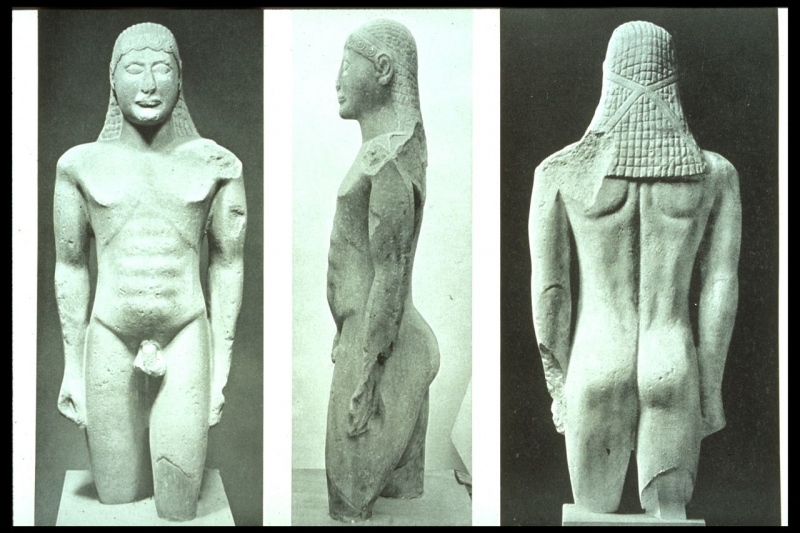
Let’s take a step back from modern ideas of posture and look to ancient models, before industrialization and various fashions pushed us away from healthy habits.
We are going to take a look at some of the wearable products which are intended, designed, and marketed to correct posture, and exclude any medical devices from this analysis. These posture wearables most often target slumpy shoulders and slouchy spines. Some work through physically shaping and restraining your body, for example with straps that pull your shoulders back. Some work through haptic feedback, for example buzzing whenever your start to slouch.
SHAPING DEVICES
Let’s start with the simplest devices, the braces and correctors which work rather like corsets in that they physically mold and hold you in a different position. There are three main problems that we see with shaping devices:
encouraging a poor ideal, such as an S-spine or a tucked pelvis
not teaching to any ideal, but pulling on the body and leaving the user to try and guess how to rearrange their body with this new limitation
targeting just one area instead of working holistically (usually while marketing that the device will fix all your postural pain)
With the first problem, you would likely be trading one unhealthy position for another, with a whole new set of pains.
In the case of the second, if a device simply prevents a negative posture like lumbar curve or slumped shoulders, it could actually be beneficial to someone who understands how to achieve good posture but hasn’t solidified their new habits yet; with a good posture education, the best use of the device is as a secondary aid.
With number three, it’s important to remember that truly good posture requires participation of the pelvis, spine, shoulders, head, ribs, knees, and feet! There is no practical device that can nudge all of these different regions into the right alignment.
CerebralBody Premium Comfortable Adjustable Posture Corrector
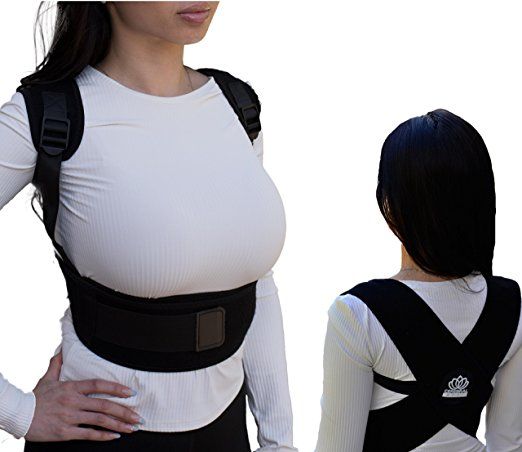
In this first example we see both a positioning back of the shoulders and flattening of the upper back. However, the model sways at her waist, bringing compression to the mid back. It is unclear whether the shape of the device encourages an S-spine or if it simply does not prevent it; but nowhere do we see an ideal J-spine.
Pelham and Strutt Postural Shapewear

In addition to physical braces there is Shapewear, which again molds the body but acts directly against the skin using sculpting, elasticated fabrics. Again, these clothing items are designed to reinforce the S-shaped spine. The upper lumbar curve is mistakenly identified as the place where you want to have the most curve, rather than at L5/S1.
Compare the difference between an S-spine and J-spine:

S-shaped spine J-shaped spine
Notice that the S-shaped spine has much deeper waist, upper back and neck curves, resulting in more pressure on the front or back of the discs, over-tight or lax muscles, and compression on nerves. The J-shaped spine, by contrast, allows the spine to lengthen and stack without these physical stresses.
These two products serve as a good representation for the range of shaping devices, most of which are variations on shoulder/back restraints, and are almost exclusively aimed at pulling the shoulders back at the expense of a sway in the lumbar spine, perpetuating the common S-spine model that actually causes harmful compression of the discs.
FEEDBACK DEVICES
So are the new generation of Biofeedback Devices doing any better? They certainly use more varied and sophisticated technologically, containing sensors that read our position and let us know (usually with a beep or vibration) when our posture is off track so that we can correct it. An important step forward with this innovation is that it actually aims to train, not merely restrain the body, so the habits you develop last even after you take the device off.
Feedback devices suffer from similar problems as shaping devices:
The device is often not aimed to a good postural model. If you are encouraged to stick a sensor on your lumbar spine that is only happy when you are swaying, or to place a sensor in a place that isn’t actually effective for picking up on bad habits, then there is no way at all users can benefit.
Many of these feedback devices require the user to set their own ‘ideal’ from which the device will judge deviation. Yet if you do not know how to comfortably sit or stand in the first place, the ideal you set will likely be unnatural and harmful, achieved with tense muscles and a poorly stacked skeleton. In this case, your device will be pestering you to constantly strain your body in this unnatural position, and reinforcing new bad habits. To get good results, you need to already have a thorough understanding of good posture.
Note that these products do have the benefit of some flexibility in how you use them and in setting and updating your ideal. If you have had posture training and know how to find a healthy position, you could indeed use a buzzer as a trainer. We are all guilty of slipping into old habits and positions, and having a wearable that notifies you when you start to backslide can be a good way to build up your stamina and ingrain your new healthy habits.As with shaping products, feedback wearables can only address one region at a time. So unless you plan to cover yourself in small vibrating devices, you must focus on one problem area. If you plan to use one of these devices as a training tool, this could be a benefit to target a region you struggle with, like slumping shoulders.
Ergo Posture Transformer
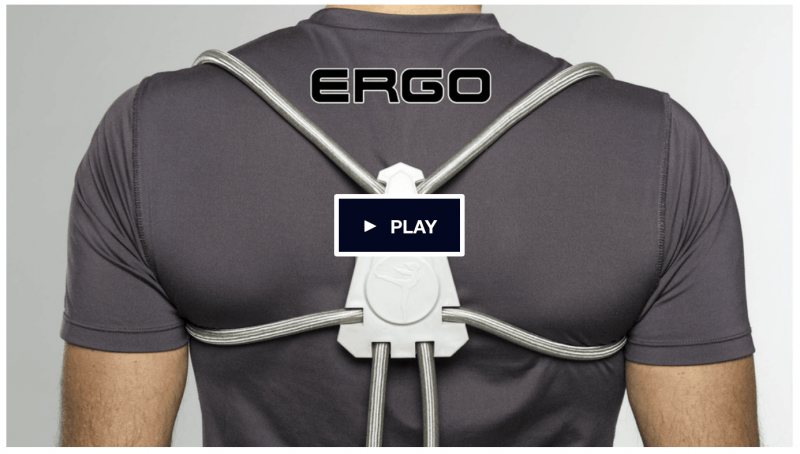
The Ergo Posture Transformer promises ‘Perfect Posture Instantly’, and combines physical molding of the body with biofeedback that mysteriously ‘triggers an automatic reflex in your thoracic vertebrae.’ It is one of many posture products looking for crowdfunding to bring it to market, and certainly includes a host of more advanced features by virtue of its comprehensive app. The app offers notifications, videos and a rather gung-ho stretch routine, which includes rolling the head (ouch!) and bending with a rounded spine (not recommended).
Its strong elastic construction aims to deliver:
Head balanced over shoulders
Shoulders back and down
Chest expanded
Abdominals engaged
This points all sound good, yet the end result, or ‘ideal’ shown on the website, is strangely stiff and tense:
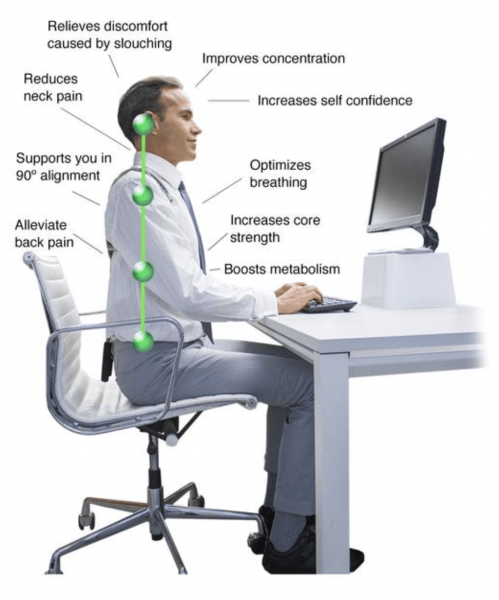
If you have taken the Gokhale Method Foundations Course or read Esther’s book, 8 Steps to a Pain-Free Back, you will know the difference between forced sitting up, and relaxed sitting well. You will also know that this man’s back and neck tension is due to sitting upright (trying to stack his spine) with a tucked pelvis, made worse by the extreme negative slant of his chair seat— an angle we do not recommend for stacksitting! This means his back muscles are tense trying to maintain an upright position.
Upright Pro/Upright Go
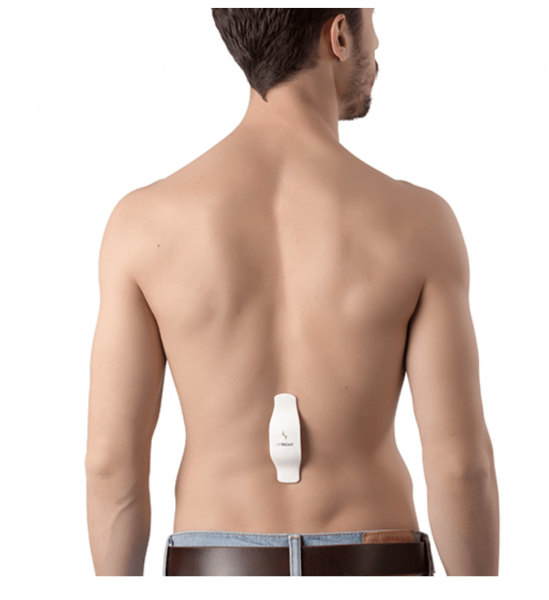
Upright Pro is an attractively designed unit that adheres to the skin using disposable pads with hypoallergenic adhesive on one side, velcro with the device on the other side. It is placed along the spine either at waist height to detect rounding of the mid lumbar vertebrae when you slump, or between your shoulder blades to detect rounding of the thoracic area. It alerts you to posture that deviates from your set ideal by vibrating; wearers are sensibly advised to build up their practice gradually, starting with 5 minutes a day.

This version of upright includes a severe sway and forward-neck—not at all an example of good posture!
You can take a look at the Upright Pro in action on YouTube. Unfortunately, in the videos you will see the models alternating between the classic relaxed/slumped and upright/tense sitting positions, each of which over time do different kinds of damage.
The UpRight Go, a new product from the same company as Upright Pro, is designed to be worn just on the upper back and is marketed as ‘the effortless way to correct your ‘screen-slouch’.’ As you can see from the more lifted front ribs and increased rucking on the back of the model’s top, this uprightness is still being obtained from a sway and tension in the back.
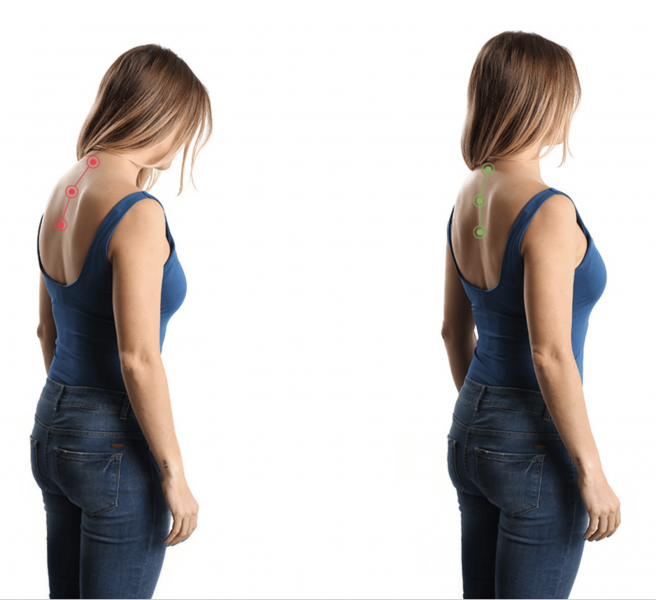
We agree that slumped sitting is not good for the spine, but when calibrating their ideal position for these two devices, people will almost inevitably train themselves to arch and tense if they have no understanding of the natural J-spine. Warning users not to hyperextend is good advice, but remains wishful thinking without pelvic anteversion. It takes learning the Gokhale Method to systematically address all the underlying causes of problematic sitting—the wrong pelvic position, the S-shaped spine ideal, badly designed furniture, poor role models, tight and weak muscles etc. With that important proviso, in-app support is comprehensive, with features such as a sensitivity slider and re-calibration options, and its dashboard also takes you to daily goals, tracks progress, and offers a library of help tutorials.
Lumo Lift
The Lumo Lift is a small, discrete unit. Little more than a chip, this one attaches via a magnet near to your collarbone on your top or lapel. It vibrates when you slouch to remind you to sit tall and stand straight and its motion sensors track your posture and activity levels throughout the day for progress tracking via the app.
Again, if you set your target posture wrong, or crucially, don’t know how to get straight without tension, you will train yourself into further bad habits.

One problem with all devices that buzz every time the spine deviates from vertical is that it may dissuade people from hip-hinging correctly. Rather than upset the sensor, people may be tempted to crane the head forward—or to bend with the knees and keep the back upright. If a sensor were to allow for hip-hinging but alert you when you sway or round your back, this could be really useful.
CONCLUSION
These devices demonstrate why piecemeal solutions that are not grounded in solid posture research and years of teaching experience, do not work well—you could be buying yourself a whole lot of new back trouble if you don’t know solid technique before using them. Just because you can force your shoulders back and tighten the slouch from your spine doesn’t mean you are actually repositioning your body to achieve healthy posture—the missing ingredient in all these devices so far.
To relieve our back pain and the epidemic of related health problems, we must rediscover our ancient body wisdom and educate ourselves on how to emulate the posture of peoples and ancestors who don’t have back pain. Here is the gold standard that will save us from replacing one st of problems with another. After getting a thorough posture education and training, however, some of these devices could be used as helpful training tools; we also see the potential for more advanced devices to deliver useful data that can point us to problem areas or problematic activities we haven’t been able to spot on our own.
The Gokhale Institute is dedicated to embracing new ways of supporting our students to relearn their primal, pain-free posture, and our approach has always combined the best of ‘high tech’ with ‘high touch’. These are exciting times and our culture is only just beginning to harness the possibilities of wearable technology and biofeedback devices. So, we would love to hear about any posture devices you have tried. What helped, what didn’t? We invite you to post below.

Comments
I would be interested to hear
I would be interested to hear what you think of the Better Back support belt. (https://getbetterback.com/)
I used one for a while during the summer, when I wanted to do lot of my computer work at the park, which meant sitting at a picnic table (Ouch! Why do they place the bench SO FAR BACK from the table?!).
The website shows a fair bit of variation in how people are wearing/placing the belt, but I found that I could adjust it fairly well to allow my tailbone/butt to be well behind me with my pelvis tipped comfortably forward, and I could more or less use the upper ridge of the belt to 'hook' my back on, similar to a stretch-sit cushion. The upper edge of the belt also gave me a little something to push back against when to remind me not to lift my ribs up in the front.
The fact that it hooks over the knees also helped train me with my most persistent habit, which is to constantly cross (und un-cross, and re-cross, and re-cross, and re-cross, and sit on) my legs the whole time I am seated.
I am curious to hear what you might have to say about this.
Thanks.
Pro's: when used well (not
Pro's: when used well (not the way it's demo'ed) can help the pelvis tip forward.
Con's: puts stress on the knees and pressure in the hip joint by jamming the femur back into the hip socket. It's also a bit of a production to put on and off and would discourage getting up and down frequently (importnat for general health).
I prefer a folded blanket used as a wedge to get the pelvis to tip forward. One phenomenon I've observed in my students is that when they learn to stack the back well, they won't crave crossing the knees quite as much.
I'm really glad you took up
I'm really glad you took up the question of "Do wearables really help people get comfortable and become pain-free?", as it's one I've been wanting to ask. It looks like the answer, at least for a few, is "Maybe, if you've received Gokhale posture education."
Since the reviews seem to be based on product literature, I think a great follow up would be for the Gokhale Institute to actually buy these sensors and try them out. The review suggests that several could be useful with a proper posture foundation. Who better to test them out, then, than the Gokhale Institute!
We have tried (and own)
We have tried (and own) several of these devices. The window in which they are useful is somewhat narrow (I'm past it!) Because of the high rate of false negatives and because it takes a sustained period of slumped posture to trigger feedback (you can set this to be shorter, but then you run into even more false positives), Gokhale Method Foundations course graduates are unlikely to find these devices any more useful than setting an alarm to go off randomly (or every hour); in fact, the devices quickly become annoying (see the reviews on Amazon.)
The long and short of it is that you need a posture education in any case, and if you've had a good posture education, these devices are not granular or accurate enough to be better than a simple alarm (with a more pleasant feedback mechanism than a buzz, hopefully) going off randomly or at a set interval.
So glad to see this article.
So glad to see this article. My daughter got me the Lumo Lift when it first came out, as she knew I had been working on posture. Did a lot of troubleshooting and finally gave up. It buzzed when I was in good posture (even according to Lumo Lift). It often wouldn't go off if I did slouch. It would come off the magnet. It was a total waste of money.
Add New Comment
Login to add commment
Login